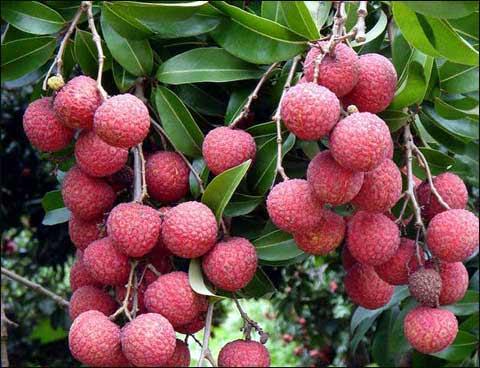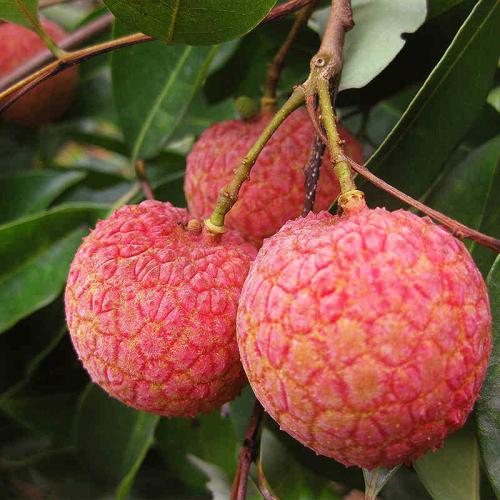Litchi pruning technology: how to trim litchi is better? How do you control winter growth?
Litchi planting technology: what is the basic tree frame pruning of litchi, and how to prune it better? If you want to know, let's take a look at it.
Basic tree frame pruning
Litchi tree frame is composed of trunk, main branch, sub-main branch and side branch. when the trunk is 50 cm above the ground, three or four main branches are cultivated, and the main branch is at an angle of about 80 degrees to the level. Two or three sub-main branches were cultured on each main branch, the angle between the sub-main branch and the horizontal was about 10-20 degrees, and the distance between the sub-main branch and the sub-main branch was about 50 cm. The sub-main branches on different main branches should not be interlaced, and the sub-main branches of the same main branch should not stay in the same direction. Three lateral branches were cultured on each submain branch.
Trim (last)
The manpower cost can account for 60% to 70% of the cultivation cost of litchi, so it is absolutely necessary to control the dwarfing of tree type to facilitate spraying and harvest. At present, the way of litchi dwarfing has developed two sets of models through the efforts of agricultural research units and farmers.
Here is a brief description as follows:
The first method is to cooperate with close planting, with a row spacing of 3 to 4 meters, 90% of the previous year's growth after harvest (only 2-3 buds at the base of the previous year's fruiting branches), or mechanical intensity pruning to control the plant below 2 meters. The suitable varieties are jade purse and the black leaves in the central region, and the suitable areas are flat land and shallow slope. In this method, the late shoots before winter are cultivated by strong shearing and fertilizer culture, and three shoots are usually cultured before flower bud differentiation in order to make use of the high fruit strength of litchi late shoots. This method can be said to give full play to the essence of labor-saving, but this method must be timely and properly controlled, otherwise, if the winter climate is unstable, such as warm winter or early cold winter and warm late winter or rainy winter, the evening shoot is often unable to get low enough low temperature to prevent flower bud differentiation, resulting in unstable yield.

Another method is to prune by hand, and the distance between rows is 6-7 meters. The method is to cut the vertically upward branches from the base at the same time (thinning and deleting), and the rest of the branches will be pruned 1 to 2 segments to control the crown amplitude, so that the height of the tree is controlled below 3 meters. When the crowns are in contact, strong pruning is adopted to maintain the yield of the orchard. The ideal of this method is to expand the fruit area of the tree as much as possible under the premise of labor-saving, in order to increase the yield per plant, and the purpose of wide row spacing is to maintain sufficient light around the tree to enrich the stored nutrients of the tree. This model is applicable to all varieties, but jade pockets often have to be treated with flower cutting or semi-flower cutting (that is, the upper part of the tree is not easy to cut flowers), otherwise too large spikes waste tree nutrients and affect the fruit. therefore, it is necessary to strengthen the improvement of fertilizer management techniques and avoid the formalities of flower cutting, otherwise, with the expansion of the cultivation area of jade purse, the profit will decrease, and the cost of flower cutting will be inconsistent.
In addition to tree type control, local pruning of branches is also quite important, and its management methods vary from variety to breed. Jade lotus and strong fruiting branches are needed to bear fruit, so each branch should be managed carefully. The method is to remove weak branches after the second or third sprouting. In principle, only one branch is retained each time so that the three shoots continue. As for glutinous rice, black leaves, cinnamon, Huaili and other non-scorched nuclear varieties, as long as not too delicate branches can bear fruit, it is only a question of how much fruit, so as long as the total yield is not affected, there is no need to care too much about how much fruit each ear bears. Therefore, the pruning method is to remove the inner branches, dense, turbulent and overlapping branches and prune them in the lateral branches or fruiting mother branches, so that the light can be penetrated, without the need for careful management of each branch to reduce the cost.
Control winter shoot
No matter what kind of pruning method is adopted, it is appropriate to control the winter shoot, especially the close planting method, and it is more necessary to control the winter shoot. At present, there are two commonly used methods of tip control. The first method is ring peeling (or ring engraving) on the main branch or sub-main branch, the ring peeling time is from late October to early November, but the middle orchard is suitable for early November; the girdling width varies according to variety, black leaves about 0.2 cm, jade purse, glutinous rice, cinnamon about 0.3-0.5 cm, it should be noted that a main branch or sub-main branch should not be girdled to avoid tree weakening. The second method is that those who have not been girdled or have been girdled but still shoot in winter can be sprayed with Yishou auxin (Ethrel 39.5%) 1200 × 2000 times to remove new shoots when the shoot is still young. In addition, before the beginning of flower bud germination in winter, the first potassium phosphate is sprayed 500 to 1000 times, once every 10 days, 2 times before and after spraying.
Whether or not to shoot in winter has a lot to do with irrigation and fertilizer management. In principle, varieties other than jade purse should not apply nitrogen fertilizer after August, and unnecessary irrigation should be avoided in winter to keep the soil moderately dry to facilitate flower bud differentiation.
Rational fertilization and utilization of leaf analysis
The so-called rational fertilization is to apply leaf nutrition diagnosis technology to recommend fertilization considering plant growth habits and variety characteristics, so as to make the quality and quantity of fertilization in line with the best economic interests. Rational fertilization can not only increase production and improve fruit quality, but also reduce production costs and enhance fruit competitiveness.
Now you know! Take good care of your tree!

- Prev

When is the best time to bag peaches? How to thinning fruit and picking heart when bagging peaches
The bagging of peaches is divided into several parts, hoping to help farmers who grow peaches. Let's have a look! 1. Central region: because the cold spell is different every winter. The time of bagging is slightly different. Peach branches are usually cut at a fixed time. The older generation taught me in front of the Winter Solstice.
- Next

How to grow tomatoes? Introduction to the precautions and skills of planting Tomato blackened at the bottom
How to grow tomatoes? Why does the bottom of the tomato turn black? What are the points for attention and skills in planting? Want to know something about it? Let's have a look together. Tomato planting method, vegetable and fruit tomato is a favorite fruit and vegetable of many people, and there are many kinds of tomato.
Related
- The first cup of black tea in spring, the flavor and history of tea gardens in Kenya, Africa
- The computer can not only choose potatoes, but also grow tea rice. AI will grow winter oolong tea champion.
- It is not only the inflated tea bitten by insects, but also engraved with the four seasons tea in Beipu.
- The Oriental Beauty Tea Festival in Zhuxian County takes the stage at the weekend to experience the plus-size feast of oil tea.
- & quot; Oriental Beauty Tea & Exploration of Emei in Hsinchu, the hometown of quot;
- The new variety of strawberry "Tainong 1" dessert is the first choice with mellow aroma. Crimson gorgeous
- History of Tea in Taiwan: from Wild Inner Mountain to Export Tea Garden
- Two types of Taiwan Oriental Beauty Black Tea won the British three-Star Award for Childhood Tea Xiang Zhang Jiaqi changed from pilot to champion tea maker.
- Banana species and varieties: the planting history of Taiwan Xianren banana and dwarf banana is long, is banana disease resistant?
- Coffee planting Technology: Qianjie Coffee from Seedling to harvesting

